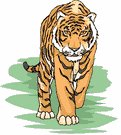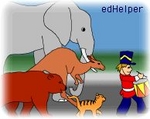1 ¡Los tigres, conocidos por su fuerza, son los gatos más grandes! Bien, mientras que la mayoría de los científicos están de acuerdo en que esto es verdad, otros argumentan que el título en realidad pertenece a los ligres.
2 Hagamos algunas comparaciones rápidas. Un tigre Siberiano puede medir más de 9 pies de largo y pesa más de 600 libras, ¡mientras que un ligre tiene una impresionante longitud corporal de casi 11 pies y un peso de más de 900 libras! ¡Espera un segundo! Obviamente, si un ligre es mucho más grande que un tigre, entonces ¿por qué la mayoría de los científicos no afirman que los ligres son los gatos más grandes? Bien, la respuesta a esa pregunta es que los ligres no son animales salvajes naturales. Cuando los científicos emparejan a un león macho con un tigre hembra, el resultado es un ligre. (Si los científicos cruzan a un león hembra con un tigre macho, sin embargo, se obtiene un tigon. Es interesante que un tigon es más pequeño que cualquiera de sus padres.) Debido a que los ligres son en realidad el producto de nuestros ingeniosos intentos casamenteros, pierden crédito cuando llega el momento de decidir cuál miembro de la familia de los gatos es el mayor.
3 Los tigres tienen rayas verticales oscuras en su cuerpo. Con excepción de su estómago blanco, la mayoría de los tigres portan un pelaje color naranja o marrón rojizo. Raras veces podemos encontrarnos algunos tigres de apariencia poco usual: blancos con rayas marrones, blancos sin rayas aparentes, o negros con rayas blancas amarillentas. Estos tigres, resultado de una mutación genética atípica, existen en estado salvaje. Muchas personas pueden pensar que los tigres blancos son albinos. No lo son, porque sus ojos son azules, no rosas.
Paragraphs 4 to 7:
For the complete story with questions: click here for printable







